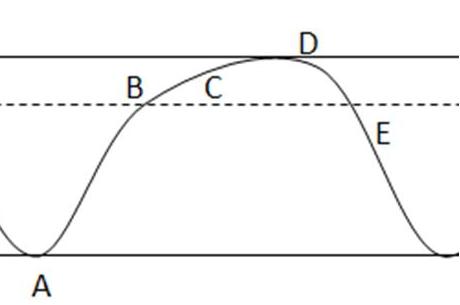Difference between revisions of "Respiratory Gas Analysis"
| Line 11: | Line 11: | ||
===Capnograph=== | ===Capnograph=== | ||
| − | [[Image:Capnograph. | + | [[Image:Capnograph.JPG|left]] |
<center> | <center> | ||
| − | {| border=" | + | {| border="0.5" cellpadding="6" |
|-style="background:#B0E0E6; color:black" | |-style="background:#B0E0E6; color:black" | ||
!'''Stage''' | !'''Stage''' | ||
| Line 24: | Line 24: | ||
|- style="background:#F0F8FF; color:black" | |- style="background:#F0F8FF; color:black" | ||
|<font color=#0C1A5D>'''B''' </font> | |<font color=#0C1A5D>'''B''' </font> | ||
| − | |Start of phase 1 | + | |Start of phase 1. |
| + | |||
| + | The beginning of the respiratory upstroke. | ||
|- | |- | ||
|<font color=#0C1A5D>'''C''' </font> | |<font color=#0C1A5D>'''C''' </font> | ||
| − | |End of phase 1 | + | |End of phase 1. |
| + | |||
| + | The beginning of the expiratory plateau. | ||
|- style="background:#F0F8FF; colour:black" | |- style="background:#F0F8FF; colour:black" | ||
|<font color=#0C1A5D>'''D''' </font> | |<font color=#0C1A5D>'''D''' </font> | ||
| Line 41: | Line 45: | ||
|} | |} | ||
</center> | </center> | ||
| − | + | ||
| − | + | ||
| − | + | * Phase 1 is the inspiratory baseline and indicates inspired carbon dioxide, therefore should be zero. | |
| − | + | * Phase 2 is the expiratory upstroke and indicates the alveoli and conducting airway carbon dioxide levels. | |
| + | * Phase 3 is the expiratory plateau which indicates pure alveoli carbon dioxide levels. | ||
| + | * Phase 4 is the inspiratory downstroke indicating the start of inspiration. | ||
===Increases in End Tidal Carbon Dioxide=== | ===Increases in End Tidal Carbon Dioxide=== | ||
Revision as of 19:44, 11 April 2009
| This article is still under construction. |
Introduction
Most patients undergoing a general anaesthetic are maintained on inhalation agents and therefore in a situation where they will be connected to an anaesthetic machine. This means that with the inhalation agent, oxygen or medical air will also be delivered as well as nitrous oxide in some cases. It is important, as in any anaesthetic, to monitor the respiratory function of the patient, including respiratory rate, rhythm, and effort, as well end-tidal carbon dioxide and anaesthetic agent levels if the equipment is available to do so.
End-Tidal Carbon Dioxide
End-tidal carbon dioxide is often measured via capnometry and capnorgraphy.
- Capnometry is the numerical display of carbon dioxide levels in the respiratory gas throughout the cycle.
- Capnography is the graphical display of carbon dioxide levels in the respiratory gas throughout the cycle.
Capnometers are either sidestream or mainstream. In sidestream capnometers, a sample line is attached to a small connector which is placed between the endotracheal tube and breathing system. Mainstream capnometer sampling chambers are small enough that they can be fitted directly to the endotracheal tube between that and the breathing system. Readings are based on absorption of infrared light by carbon dioxide.
Capnograph
| Stage | Represents |
|---|---|
| A | Exhalation of Carbon Dioxide from dead space.
End tidal carbon dioxide should be zero at this point |
| B | Start of phase 1.
The beginning of the respiratory upstroke. |
| C | End of phase 1.
The beginning of the expiratory plateau. |
| D | End of the expiratory plateau.
This is the maximum end tidal carbon dioxide level. It is the beginning of the inspiration and phase 4. |
| E | End of inspiration.
End tidal carbon dioxide should reach zero at this point. |
- Phase 1 is the inspiratory baseline and indicates inspired carbon dioxide, therefore should be zero.
- Phase 2 is the expiratory upstroke and indicates the alveoli and conducting airway carbon dioxide levels.
- Phase 3 is the expiratory plateau which indicates pure alveoli carbon dioxide levels.
- Phase 4 is the inspiratory downstroke indicating the start of inspiration.
Increases in End Tidal Carbon Dioxide
- Impaired alveolar ventilation.
- Increased metabolism.
- Increased cardiac output.
- Rebreathing.
Decreases in End Tidal Carbon Dioxide
- Hyperventilation.
- Low cardiac output.
- Pronounced hypothermia.
- Failing circulation and cardiac arrest.
Inhaled and Exhaled Anaesthetic Agents
With some of the monitors now available it is also possible to monitor the inhaled and exhaled anaesthetic agent concentration. This allows monitoring of dosing of inhalant anaesthetics (inhaled value) and the exhaled value indicates the concentration in the circulation and brain.
